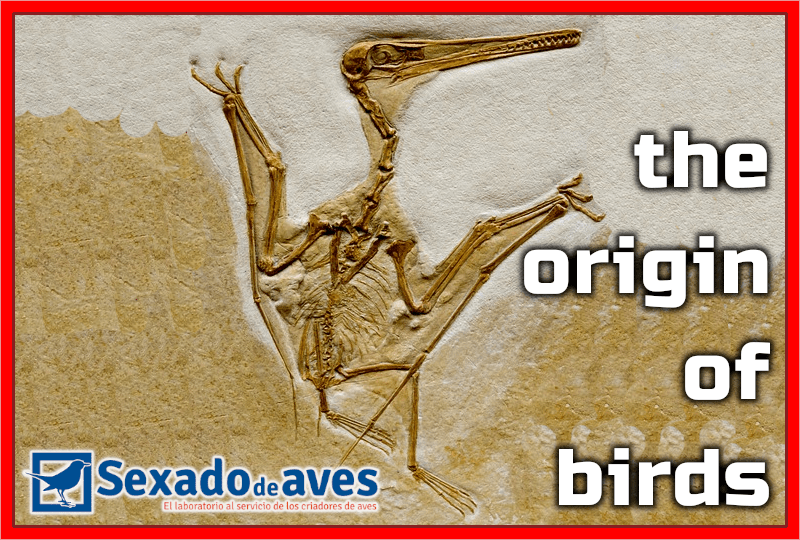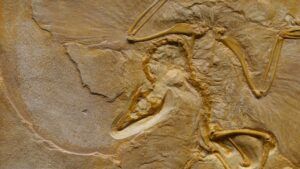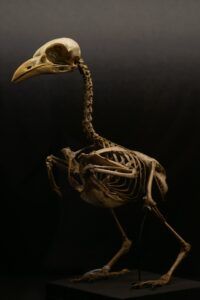The Origin of Birds
New World View In 1859 a scientific revolution began . This was initiated by the publication of Charles Darwin´s world changing book ՙOn the Origin of Species՚. This book challenged orthodox views and layed the foundations

New World View
In 1859 a scientific revolution began . This was initiated by the publication of Charles Darwin´s world changing book ՙOn the Origin of Species՚. This book challenged orthodox views and layed the foundations of evolutionary biology. In his book Darwin layed out the scientific theory that populations evolve over generations through natural selection and provided evidence that the diversity of life on earth evolved from a common origin through a branching pattern of evolution. Darwin´s theory of evolution was to have consequences concerning the origin of birds.
Major Discovery
In 1860 (the year after the publication of Darwin´s revolutionary book), a solitary fossilized feather was found in Germany in a limestone deposit estimated to be approximately 150 million years old. Then in the following year it was announced that a fossil of a small dinosaur which appeared to have feathers had been discovered in the same proximity. This fossil known as Archaeopteryx was a major discovery and initiated a debate on the origin of birds.
Archaeopteryx
Archaeopteryx which was the size of a Raven had broard wings that were rounded at the ends with feathers that were very similar to those of modern birds. However, it also had features that are not shared by modern birds such as a long bony tail and small teeth. The shared and unshared features led to the conscensus that Archaeopteryx was a transitional species between non-avian dinosaurs and birds.

Theropods
The theropods are a group of small carnivous dinosaurs characterized by hollow bones and three-toed limbs. Thomas Henry Huxley (the grandfather of the great thinker and writer Aldous Huxley) who became known as Darwin´s defender compared a giant theropod (Megalosaurus) with the ostrich and found 35 features that they shared in common. This led him to suggest that birds could have evolved from theropods . However, this was contested by the paleontologist Harry Govier Seeley who argued that these shared features could have resulted because Megalosaurus like the ostrich was bipdal and could have used its legs in a similar way.
Early twentieth century
Early in the twentieth century Gerhard Heilmann of Denmark compared Archaeopteryx and other prehistoric reptiles with birds. Like Huxley before him he thought that the theropods could have been the ancestors of birds . However, modern birds have collar bones (clavicles) which have fused to form a wishbone (furcula). Although clavicles were known to be present in more primitive reptiles, in Heilmann´s day they had not been recognized in dinosaurs. Heilmann therefore concluded that the similarities between theropods and modern birds were the result of the independent evolution of similar features (convergent evolution).
1970´s and 80´s
In the 1970´s there began a renaissance in the study of dinosaurs, a rebirth that has continued to the present day. A prominant participant in this resurgence was the paleontologist John Ostrom who following Huxley and Heilmann also noticed the similarities between theropods and birds. This interest coincided with the development of Phylogenetic systematics which there in led in the 1980´s to the consensus that birds had in fact evolved from theropods.
Phylogenetic systematics
Phylogenetic systematics commonly known as cladistics is a field of biology that reconstructs evolutionary history and the patterns of relationships among organisms. It uses Darwin´s precept that heritable traits emerge and are passed on genetically to descendants. It assumes therefore, that two groups sharing a trait are likely to be related. Evolutionary trees known as cladograms are formed by grouping organisms based exclusively on certain kinds of shared traits. A group composed of an ancestor and its descendants (a closely related group) is known as a clade.
The Origin of Birds from their theropod ancestors
In the 1990´s the quantity of bird like fossil´s available for investigation was greatly augmented with the discovery of many spectacular specimens in China. Collecting together all of the fossil evidence scientists have now unequivocally demonstrated using cladistics that theropods gradually passed through a series of complex stages eventually evolving into birds thereby terminating the debate on the origin of birds. The transition of the first feathered dinosaurs to the emergence of modern birds took approximately 150 million years. https://www.youtube.com/watch?v=z4nuWLd2ivc
The First Feathers
Approximately 120 million years ago there lived a theropod known as Sinosaropteryx. This dinosaur had short hair-like feathers on its head, neck, and body. These primitive feathers in all probability initially served as insulation, and as time passed evolved different color patterns thereby facilitating additional functions such as species recognition, camouflage, and displays.
As evolutionary time passed feathers then became more sophisticated. This can be seen in the theropod Oviraptorosaur which had feathers that were branched and more downy. By the time Archaeopteryx arrived on the scene feathers had evolved a structure very similar to those of modern birds.
The forelimbs
The hands of early theropod dinosaurs had small fourth and fifth digits and a long second digit. Overtime the fourth and fifth digits were lost and the wrist bones underlying the first and second digits consolidated becoming semi-circular in form thereby facilitating the rotation of the hand sideways against the forearm. These anatomical modifications led to the emergence of wing joints that now allow modern birds to create the thrust that they need for flight.
Bones
In the time that passed from early theropods to modern birds, many bones fused with other bones. Bones also evolved thinner walls and hollow spaces (pneumatized bones) thereby becoming lighter. These modifications would have greatly improved the efficiency of flight.
Flight Apparatus
Along the spectrum of change from theropod to modern bird feathers became longer with asymmetrical vanes and the bony tail was reduced to a stump with sprayed feathers to create a feathered tail that allowed for better maneuverability. The wishbone also became stronger and more elaborate and the shoulder girdle connected to the breastbone thereby securing the flight apparatus of the forelimb. There was also an enlargement in the breastbone which evolved a central keel to anchor the flight muscles.

Teeth loss
The ancestors of birds gradually lost their teeth and developed gastroliths (gizzard/stomach Stone) to grind food. A gastrolith is a rock held inside the gastrointestinal tract to grind food by some animals that lack suitable grinding teeth. https://www.sexadodeaves.com/vlog/en/scavenging-birds-indispensable-in-the-food-chain/
Behavioural changes
As time passed the arms became longer than the legs and the mode of movement changed from running to flight. Nest building and brooding behaviours also developed. The emergence of birds began about 160 million years ago and occurred over tens of millions of years. There are now more than 9000 bird species.
At Hispalis Biolab we provide various laboratory services for bird breeders and bird lovers in general. These include genetic profiling/fingerprinting/genotyping), infectious disease screening, and genetic sex identification.

Pingback:Bird Flight - aViblog - El mejor contenido para los amantes de las aves April 19, 2021